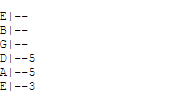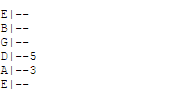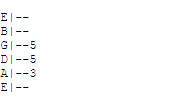Do You Really Need Power Chords?
I got this question from one of my students. Power chords have been used since the 60s (maybe earlier), mostly in Rock genres. If you’re an older player like me, do you still need them?
Let’s start by finding out what they are. “Power Chords” are essentially 5th chords (notated as G5 for a G power chord). It’s just the root note and a fifth on top. If you play the third fret on the sixth string (G) and the fifth fret on the fifth string (D), you’d have a G power chord.
(Note: You can add the octave of the root to make it a little more full. In our G power chord, that’s the fifth fret on the fourth string.)
Most of the time power chords are used on electric guitars with distortion. But they sound OK on acoustic guitar too. The easiest way to fret a power chord is like this (using G again):

- Fifth String - Fifth Fret (Ring Finger)
- Sixth String - Third Fret (Index Finger)
And if you add the Octave:

- Fourth String - Fifth Fret (Pinky)
- Fifth String - Fifth Fret (Ring Finger)
- Sixth String - Third Fret (Index Finger)
Power chords themselves aren’t major or minor. They’re technically not even full chords. Full chords need a minimum of three notes (the root, third, and fifth). So with power chords you get implied chords. This varies based on the key you’re in. Our ears are naturally trained to fill in the blanks so they sound musical.
You'll notice I'm actually not hitting all the strings. And there's a couple of ways to deal with that. I can kind of angle my pick a little bit so it goes out over the strings instead of straight down.
But I’ve also developed a left hand technique that’s incredibly valuable. While I’m fretting the chord, the rest of my hand is gently resting on the rest of the strings. This dampens and mutes them. It’s all about finding the perfect touch. And it takes a lot of practice so don’t stress too much.
You can do the same shape on the fifth string.

And with the Octave:

You can even play power chords with a root on the fourth string. It’s better to drop the octave here. That has to do with the interval between the third and second strings. The shape changes.

The name of every power chord will be root (lowest) note. So if you start on the third fret fifth string, it would be a C power chord. Two frets up would be a D power chord. And so on.
If you’re playing electric guitar you’ll find a lot of places to use them. On acoustic guitar...not so much. But let’s face it, playing guitar is fun. And it’s fun to explore different techniques and chords. So you might find a good place for power chords on an acoustic.
I’d love to hear what you think. Do you think power chords have a place on acoustic guitar? Let me know in the comments.
Check out the video for a few examples of power chords in songs (0:12). And bonus points if you can name the song titles and the bands.
Thanks for joining me today. I'm Tomas Michaud and I hope to see you in the academy. Bye for now.
Tell Us What You Think - Please Comment Below!
We would love to hear your comments and questions. What specific things are you struggling with while learning guitar?

Guitar knowledge…. always good to know. Make music with all the tricks. Electric or acoustic, Guitar is guitar. It all depends on what and how you play.